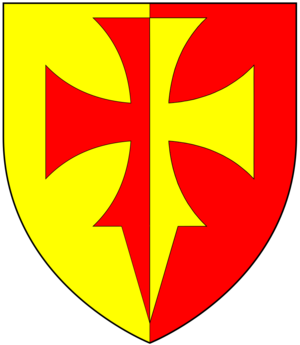Hugh Clopton facts for kids
Quick facts for kids
Hugh Clopton
|
|
|---|---|

Arms of Clopton of Clopton, in the parish of Stratford-upon-Avon, Warwickshire: Per pale or and gules, a cross patée fitchée counterchanged. As seen on the monument to George Carew, 1st Earl of Totnes (1555–1629), and his wife Joyce Clopton (died 1637) in the Church of the Holy Trinity, Stratford-upon-Avon
|
|
| Lord Mayor of London | |
| In office 1491–1492 |
|
| Preceded by | John Matthew |
| Succeeded by | William Martyn |
| Personal details | |
| Born | 1430 Clopton House, Warwickshire, England |
| Died | 15 September 1500 St Margaret Lothbury, London, England |
Hugh Clopton (born around 1440 – died 15 September 1496) was an important person in London. He became the Lord Mayor of London. He was also part of the Worshipful Company of Mercers, which was a powerful group of merchants. Hugh Clopton was very generous to his hometown of Stratford-upon-Avon in Warwickshire.
Contents
Early Life and Family
Hugh Clopton was born around 1440. His family lived at Clopton House near Stratford-upon-Avon. The Clopton family had lived there for a long time. They had been there since the time of King Henry III. Hugh was a younger son of John Clopton. His mother's name was Agnes.
Because he was a younger son, Hugh needed to make his own way. He moved to the City of London when he was young.
Becoming a Successful Merchant
In London, Hugh Clopton became an apprentice in 1457. He learned the trade of a mercer. Mercers were merchants who dealt in fine fabrics and goods. In 1464, he joined the Worshipful Company of Mercers. This was a very important and powerful group of merchants.
Hugh Clopton served as a leader in the Mercers Company. He was chosen as Warden three times. This happened in 1479, 1484, and 1488.
Political Career in London
Hugh Clopton became an important figure in London's government. On October 15, 1485, he was chosen as an Alderman. This meant he was a senior member of the city council. In 1486, he was elected Sheriff of London. The Sheriff helped the Lord Mayor keep order in the city.
In 1491, Hugh Clopton himself was chosen as Lord Mayor of London. This was a very high honor. He was a wealthy and respected citizen.
Contributions to Stratford-upon-Avon
Hugh Clopton never forgot his hometown. He used his great wealth to help Stratford-upon-Avon. He even bought back his family's ancestral lands.
Around 1483, he built a nice house in Stratford. It was made of brick and timber. Later, in 1597, the famous writer William Shakespeare bought this house. It was called New Place. Shakespeare lived there until he died in 1616.
Clopton also helped improve the town's buildings. He rebuilt the main part of the Chapel of the Stratford Guild. This chapel was across from his new house. He added a tower, a steeple, and beautiful windows. He also paid for paintings on the ceiling.
One of his biggest projects was the Clopton Bridge. He built a strong stone bridge over the River Avon. It had fourteen arches. He paid to remove an old wooden bridge first. This new bridge was a major improvement for the town. He also started the Clopton chantry chapel in the Church of the Holy Trinity, Stratford-upon-Avon. These buildings are still important parts of Stratford today.
Death and Legacy
Hugh Clopton died on September 15, 1497. He owned the Clopton manor. He left his property to his great-nephew, William Clopton.
In his will, Hugh Clopton made sure his projects in Stratford were finished. He left money for many good causes. He gave money to help young women in the town. He also gave money to rebuild part of the parish church. He even set up scholarships for poor students. These scholarships helped students attend Oxford and Cambridge.
Hugh Clopton wanted to be buried in Stratford if he died there. However, he died in his London home. He was buried in the church of St Margaret Lothbury in London.
Hugh Clopton never married and had no children. His family's estates eventually went to Joyce Clopton. She was a descendant of Hugh's elder brother. She married George Carew, 1st Earl of Totnes. He inherited the Clopton manor through his wife. They are both buried in Stratford Church. Their monument there is very grand.

